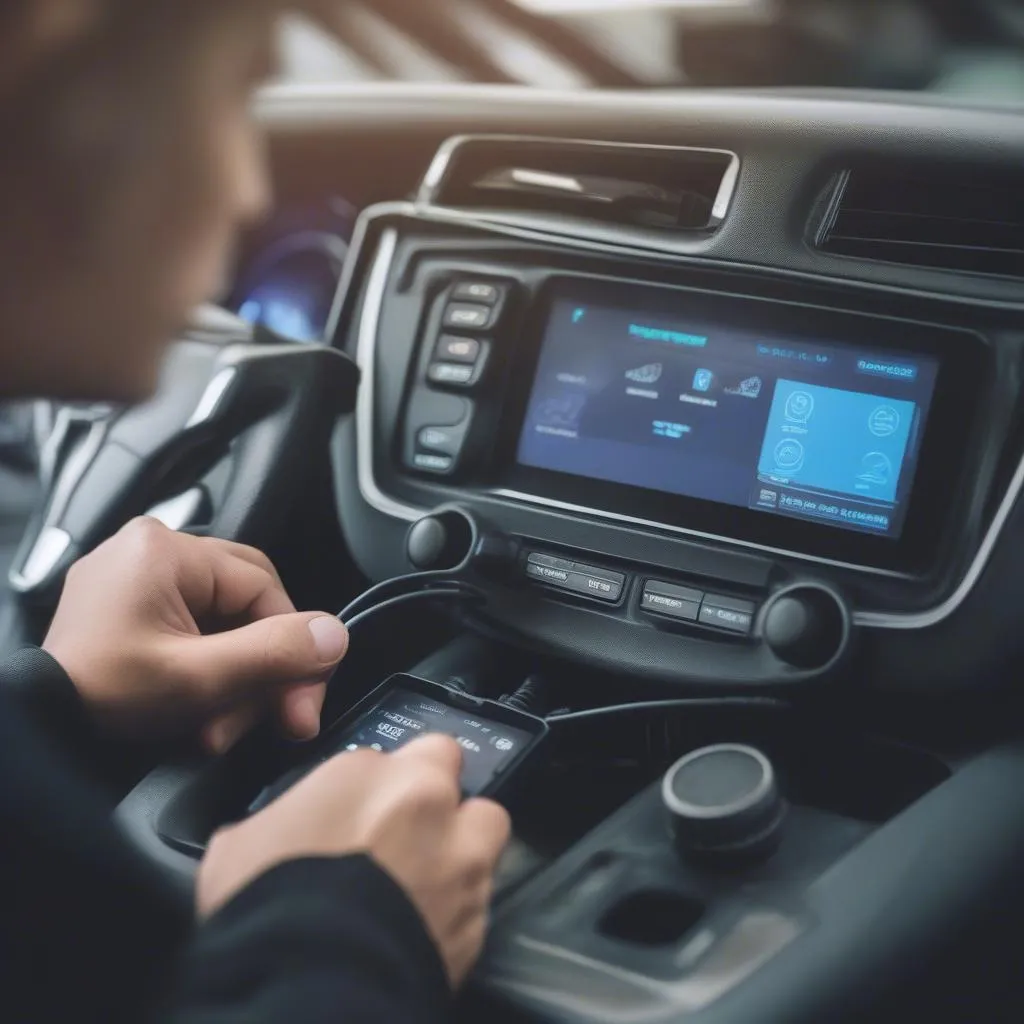Have you ever found yourself stranded on the side of the road, wondering what’s wrong with your car? The dreaded “check engine” light illuminates, but you’re left clueless about the underlying issue. It’s frustrating, right? Thankfully, there’s a powerful tool that can shed light on your car’s health: the **OBD diagnostic interface**.
What is an OBD Diagnostic Interface?
Think of the OBD diagnostic interface as your car’s secret language translator. It’s a standardized communication protocol that allows you to access and interpret data from your vehicle’s onboard computer. This data provides invaluable insights into your car’s performance, potential issues, and even its emissions levels.
The Power of an OBD Interface
The beauty of an OBD interface lies in its ability to connect you with your car’s electronic brains. It empowers you to:
1. Identify Engine Problems
Imagine the “check engine” light flickers on. Instead of panicking, you plug in your OBD interface and within seconds, you see a code that tells you exactly what’s wrong: a faulty oxygen sensor. This saves you countless hours of guessing and unnecessary visits to the mechanic.
2. Track Your Car’s Performance
Beyond troubleshooting, you can use your OBD interface to monitor your car’s performance in real time. Track parameters like engine temperature, fuel consumption, speed, and even acceleration. This information can help you identify potential problems early on and optimize your driving efficiency.
3. Optimize Your Driving Habits
By analyzing your driving data, you can identify areas where you can improve your driving efficiency. For instance, you might discover that your aggressive acceleration is negatively impacting your fuel consumption. Armed with this knowledge, you can adapt your driving style to save money on fuel and reduce your carbon footprint.
Commonly Asked Questions about OBD Diagnostic Interfaces
Q: Is an OBD diagnostic interface compatible with all vehicles?
A: While OBD interfaces are standardized, not all vehicles are compatible with them. Most vehicles manufactured after 1996 in the United States, 2001 in the European Union, and 2005 in Japan are equipped with the OBD-II standard. However, older vehicles or vehicles from some specific manufacturers might require specialized interfaces.
Q: What type of information can an OBD interface provide?
A: An OBD interface can provide a wealth of information, including:
- Diagnostic Trouble Codes (DTCs): These codes provide detailed information about any detected malfunctions in the car’s system.
- Live Data: This data displays real-time information on various parameters, such as engine speed, fuel pressure, and oxygen sensor readings.
- Freeze Frame Data: This data captures the vehicle’s conditions at the time of a detected malfunction.
- Vehicle Identification Number (VIN): This unique identifier helps you confirm the car’s identity.
Q: Can I use an OBD interface to modify my car’s performance?
A: While some OBD interfaces allow for limited modifications, it’s crucial to proceed with caution. Using an OBD interface for performance tuning can be risky and may void your car’s warranty.
Q: What kind of OBD interface should I choose?
A: The ideal OBD interface depends on your needs and budget. Here are some factors to consider:
- Compatibility: Ensure that the interface is compatible with your vehicle’s year, make, and model.
- Features: Consider the types of data you need and the features you desire, such as live data streaming, code clearing, and performance tuning capabilities.
- Price: Prices vary widely depending on features and brand.
How to Use an OBD Diagnostic Interface
Using an OBD diagnostic interface is simple and intuitive. Follow these steps:
- Connect the interface: Plug the OBD interface into the OBD-II port, typically located under the dashboard.
- Download and install software: Download the appropriate software on your computer or smartphone.
- Connect to the interface: Use Bluetooth or Wi-Fi to connect your device to the OBD interface.
- Access and interpret data: Use the software to browse through the data, read DTCs, or track live readings.
Resources for Further Learning
For a deeper understanding of OBD diagnostic interfaces, consider exploring these resources:
- “OBD-II Automotive Diagnostics: A Practical Guide to Diagnostic Testing and Repair” by Dennis G. Arnold: This book offers a comprehensive guide to OBD-II systems and diagnostics.
- “OBD-II For Dummies” by Ken Freund: This approachable book provides a beginner-friendly introduction to OBD-II technology.
The Future of Vehicle Diagnostics
OBD interfaces are constantly evolving, with new features and functionalities emerging regularly. Advancements like wireless connectivity and integration with smartphone apps are transforming the way we interact with our vehicles. As technology progresses, OBD interfaces are becoming increasingly powerful tools for enhancing our driving experience and ensuring the optimal health of our cars.
Conclusion
OBD diagnostic interfaces are invaluable tools for anyone who wants to gain deeper insights into their vehicle’s health. By utilizing an OBD interface, you can take control of your car’s maintenance, identify potential problems early, and optimize your driving experience. Whether you’re a seasoned mechanic or a curious driver, the OBD diagnostic interface empowers you to understand your car better.
Ready to unlock the secrets of your vehicle? Contact us on Whatsapp at +84767531508 for expert support on setting up and using your OBD diagnostic interface. We’re here to help you keep your car running smoothly.
Do you have more questions about OBD diagnostic interfaces? Share them in the comments below!
Check out these related articles on our website:


